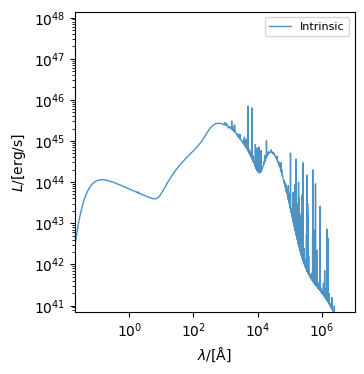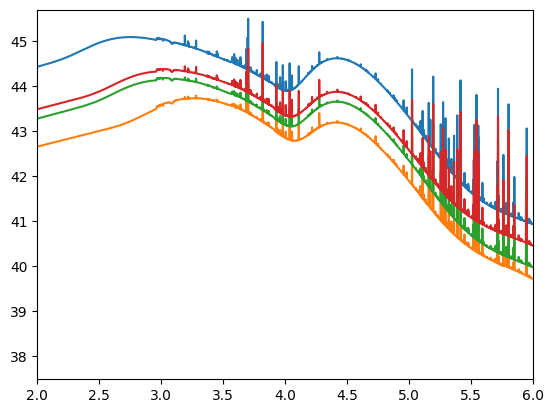Blackholes¶
Synthesizer has a collection of routines allowing us to also model the spectral energy distributions of black holes (i.e. AGN) and combine their emission with the emission of others galaxy components (i.e. stellar emission).
Particle blackholes¶
[1]:
import matplotlib.pyplot as plt
import numpy as np
from synthesizer import galaxy
from synthesizer.blackhole_emission_models import UnifiedAGN
from synthesizer.particle import BlackHoles, Gas
# Set a random number seed to ensure consistent results
np.random.seed(42)
Creating Particle Blackholes¶
Before generating some simple observational quantities from physical properties we first need to create a BlackHoles object. This object can be found in synthesizer/particle/blackholes.py.
Lets create an instance of BlackHoles containing 4 fake black holes. To do so we can provide a number of optional keyword arguments but for now lets just provide their masses, metallicities, coordinates and accretion rates (the parameters required for spectra calculation). Note that masses and accretion_rates are positional arguments and must therefore always be provided for particle.BlackHoles, while parametric.BlackHoles have more flexibility (see the parametric black
hole docs).
[2]:
# Make fake properties
n = 4
masses = 10 ** np.random.uniform(low=7, high=9, size=n) # Msun
coordinates = np.random.normal(0, 1.5, (n, 3)) # cMpc
accretion_rates = 10 ** np.random.uniform(
low=-2, high=1, size=n
) # Msun # Msun / yr
metallicities = np.full(n, 0.01)
# And get the black holes object
bh = BlackHoles(
masses=masses,
coordinates=coordinates,
accretion_rates=accretion_rates,
metallicities=metallicities,
)
For some emission models we require an inclination. This could, in principle be calculated from the simulation and passed at instantiation, but for now we can use an in-built method to generate random inclinations.
[3]:
bh.calculate_random_inclination()
print(bh.inclination)
[41.04629858 70.66583653 17.97064039 46.28109946] degree
Blackhole properties¶
On initialisation a handful of properties are automatically calculated if there prerequists are provided. For example, with masses and accretion_rates bolometric_luminosities ($ L_{\rm \bullet, bol} = \epsilon{r}:nbsphinx-math:`dot{M}`{\bullet}c^{2} $) are automatically calcualted. Note that the radiative efficency (epsilon) defaults to 0.1 but can be passed as an array with a value for each particle.
[4]:
bh.bolometric_luminosities
[4]:
unyt_array([3.87796015e+45, 1.48431556e+44, 4.26067691e+44, 7.11426744e+44], 'erg/s')
Here are some more examples of calculated properties.
[5]:
print(bh.eddington_ratio)
print(bh.accretion_rate_eddington)
print(bh.eddington_luminosity)
[0.54977859 0.00148171 0.01164543 0.03593171]
[0.54977859 0.00148171 0.01164543 0.03593171]
[7.05367613e+45 1.00176047e+47 3.65866934e+46 1.97994099e+46] erg/s
As with most Synthesizer objects a summary of the object can be printed using print.
[6]:
print(bh)
--------------------------------------------------------------------------------
SUMMARY OF BLACKHOLE
Number of blackholes: 4
mass: [5.61151642e+07 7.96945482e+08 2.91063591e+08 1.57513205e+08] dimensionless
accretion_rate: [0.685 0.026 0.075 0.126] dimensionless
accretion_rate_eddington: [0.55 0.001 0.012 0.036]
bolometric_luminosity: [3.87796015e+45 1.48431556e+44 4.26067691e+44 7.11426744e+44] dimensionless
eddington_ratio: [0.55 0.001 0.012 0.036]
bb_temperature: [272017.955 31926.706 68764.227 106257.824] dimensionless
eddington_luminosity: [7.05367613e+45 1.00176047e+47 3.65866934e+46 1.97994099e+46] dimensionless
epsilon: [0.1]
inclination: [41.046 70.666 17.971 46.281] dimensionless
cosine_inclination: [0.754 0.331 0.951 0.691]
Blackhole spectra and lines¶
Blackhole spectra (and lines) can be generated by combining the BlackHoles object with an emission model. An emission model translates the physical properties of the blackhole(s) (e.g. mass, accretion_rate, etc.) to an spectral energy distribution. These models are described in more detail in the associated workbook.
[7]:
# Define the emission model
grid_dir = "../../../tests/test_grid/"
emission_model = UnifiedAGN(
disc_model="test_grid_agn", photoionisation_model="", grid_dir=grid_dir
)
To generate spectra we then simply call the get_intrinsic_spectra method which will return us an Sed object (see the Sed docs) containing the intrinsic integrated spectra and will also store all the spectra that went into its creation in a spectra dictionary on the BlackHoles object.
[8]:
# Generate the integrated spectra
spectra = bh.get_spectra_intrinsic(
emission_model, verbose=True, grid_assignment_method="ngp"
)
/opt/hostedtoolcache/Python/3.10.14/x64/lib/python3.10/site-packages/unyt/array.py:1824: RuntimeWarning: overflow encountered in exp
out_arr = func(np.asarray(inp), out=out_func, **kwargs)
Note that we can also include the effects of diffuse dust attenuation and emission. For details see the parametric black hole docs.
We can now examine a single component, in this case the total intrinsic emission, using the plot_spectra helper method.
[9]:
fig, ax = bh.plot_spectra(
show=True,
spectra_to_plot=[
"intrinsic",
],
quantity_to_plot="luminosity",
)

In addition to integrated spectra we can get a spectra per particle by calling the get_particle_spectra_intrinsic method. This will produce a 2D Sed containing the intrinsic spectra for each particle and store all created spectra in the particle_spectra dictionary on the BlackHoles object.
[10]:
# Generate the particle spectra
spectra = bh.get_particle_spectra_intrinsic(
emission_model, verbose=True, grid_assignment_method="ngp"
)
sed = bh.particle_spectra["intrinsic"]
print(sed)
plt.plot(np.log10(sed.lam), np.log10(sed.luminosity.T))
plt.ylim(
np.max(np.log10(sed.luminosity)) - 8,
np.max(np.log10(sed.luminosity)) + 0.2,
)
plt.xlim([2, 6])
plt.show()
----------
SUMMARY OF SED
Number of wavelength points: 9244
Wavelength range: [0.00 Å, 299293000000.00 Å]
log10(Peak luminosity/erg/(Hz*s)): 31.17
log10(Bolometric luminosity/erg/s):[44.41598908 42.1165962 43.41035776 43.14647549]----------
/opt/hostedtoolcache/Python/3.10.14/x64/lib/python3.10/site-packages/unyt/array.py:1824: RuntimeWarning: divide by zero encountered in log10
out_arr = func(np.asarray(inp), out=out_func, **kwargs)

Calculating black hole metallicity¶
If we want to calculate emission from the black hole we will need to know the metallicity of the emission regions surrounding the black hole. Above we could have passed an array of metallicities at instantiation but most of the time we will not know ahead of time what these values should be. Instead we can use the gas surrounding the black hole to calculate what this metallicity is. To do this we need to first create a Galaxy with both a Gas component and BlackHoles, again using fake
data.
[11]:
# Make fake gas properties
ngas = 200
ms = np.full(ngas, 10**6.5) # Msun
pos = np.random.normal(0, 1.5, (ngas, 3)) # cMpc
hsml = np.full(ngas, 0.75) # cMpc
metals = np.full(ngas, 0.01)
# And make the gas object
gas = Gas(
masses=ms, metallicities=metals, coordinates=pos, smoothing_lengths=hsml
)
# And now create the galaxy
galaxy = galaxy(stars=None, gas=gas, black_holes=bh)
/tmp/ipykernel_2569/2976668452.py:9: RuntimeWarning: Neither dust mass nor dust to metal ratio provided. Assuming dust to metal ratio = 0.3
gas = Gas(
/home/runner/work/synthesizer/synthesizer/src/synthesizer/particle/galaxy.py:110: RuntimeWarning: In `load_stars`: one of either `initial_masses`, `ages` or `metallicities` is not provided, setting `stars` object to `None`
self.load_stars(stars=stars)
/home/runner/work/synthesizer/synthesizer/src/synthesizer/particle/galaxy.py:297: RuntimeWarning: Star forming gas particle mask not provided, setting sf_gas_mass and sf_gas_metallicity to `None`
self.calculate_integrated_gas_properties()
/home/runner/work/synthesizer/synthesizer/src/synthesizer/particle/galaxy.py:121: RuntimeWarning: Star forming gas particle mask not provided, setting sf_gas_mass and sf_gas_metallicity to `None`
self.calculate_integrated_gas_properties()
Now we have the galaxy we can use galaxy.calculate_black_hole_metallicity() to calculate the black holes’ metallicity. This method will find all gas particles with smoothing lengths that intersect the black hole and calculate the mass weighted average of their metallicity. If a black hole does not find any gas neighbours then a default metallicity is set instead, by default this is solar metallicity (0.012) but can be overwritten by passing a new default_metallicity as shown below.
[12]:
galaxy.calculate_black_hole_metallicity(default_metallicity=0.07)
print("Z_BH =", galaxy.black_holes.metallicities)
Z_BH = [0.01 0.01 0.01 0.07]